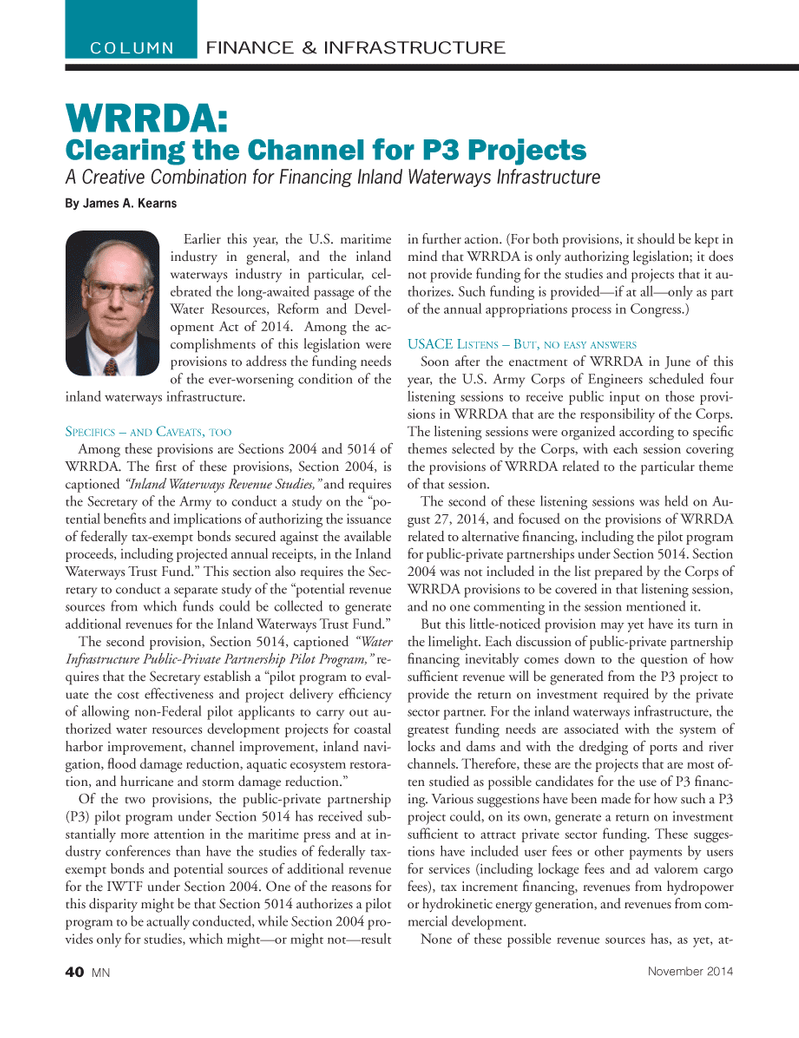
Page 40: of Marine News Magazine (November 2014)
Workboat Annual
Read this page in Pdf, Flash or Html5 edition of November 2014 Marine News Magazine
Earlier this year, the U.S. maritime industry in general, and the inland waterways industry in particular, cel- ebrated the long-awaited passage of the
Water Resources, Reform and Devel- opment Act of 2014. Among the ac- complishments of this legislation were provisions to address the funding needs of the ever-worsening condition of the inland waterways infrastructure.
SPECIFICS – AND CAVEATS, TOO
Among these provisions are Sections 2004 and 5014 of
WRRDA. The fi rst of these provisions, Section 2004, is captioned “Inland Waterways Revenue Studies,” and requires the Secretary of the Army to conduct a study on the “po- tential benefi ts and implications of authorizing the issuance of federally tax-exempt bonds secured against the available proceeds, including projected annual receipts, in the Inland
Waterways Trust Fund.” This section also requires the Sec- retary to conduct a separate study of the “potential revenue sources from which funds could be collected to generate additional revenues for the Inland Waterways Trust Fund.”
The second provision, Section 5014, captioned “Water
Infrastructure Public-Private Partnership Pilot Program,” re- quires that the Secretary establish a “pilot program to eval- uate the cost effectiveness and project delivery effi ciency of allowing non-Federal pilot applicants to carry out au- thorized water resources development projects for coastal harbor improvement, channel improvement, inland navi- gation, fl ood damage reduction, aquatic ecosystem restora- tion, and hurricane and storm damage reduction.”
Of the two provisions, the public-private partnership (P3) pilot program under Section 5014 has received sub- stantially more attention in the maritime press and at in- dustry conferences than have the studies of federally tax- exempt bonds and potential sources of additional revenue for the IWTF under Section 2004. One of the reasons for this disparity might be that Section 5014 authorizes a pilot program to be actually conducted, while Section 2004 pro- vides only for studies, which might—or might not—result in further action. (For both provisions, it should be kept in mind that WRRDA is only authorizing legislation; it does not provide funding for the studies and projects that it au- thorizes. Such funding is provided—if at all—only as part of the annual appropriations process in Congress.)
USACE LISTENS – BUT, NO EASY ANSWERS
Soon after the enactment of WRRDA in June of this year, the U.S. Army Corps of Engineers scheduled four listening sessions to receive public input on those provi- sions in WRRDA that are the responsibility of the Corps.
The listening sessions were organized according to specifi c themes selected by the Corps, with each session covering the provisions of WRRDA related to the particular theme of that session.
The second of these listening sessions was held on Au- gust 27, 2014, and focused on the provisions of WRRDA related to alternative fi nancing, including the pilot program for public-private partnerships under Section 5014. Section 2004 was not included in the list prepared by the Corps of
WRRDA provisions to be covered in that listening session, and no one commenting in the session mentioned it.
But this little-noticed provision may yet have its turn in the limelight. Each discussion of public-private partnership fi nancing inevitably comes down to the question of how suffi cient revenue will be generated from the P3 project to provide the return on investment required by the private sector partner. For the inland waterways infrastructure, the greatest funding needs are associated with the system of locks and dams and with the dredging of ports and river channels. Therefore, these are the projects that are most of- ten studied as possible candidates for the use of P3 fi nanc- ing. Various suggestions have been made for how such a P3 project could, on its own, generate a return on investment suffi cient to attract private sector funding. These sugges- tions have included user fees or other payments by users for services (including lockage fees and ad valorem cargo fees), tax increment fi nancing, revenues from hydropower or hydrokinetic energy generation, and revenues from com- mercial development.
None of these possible revenue sources has, as yet, at-
FINANCE & INFRASTRUCTURECOLUMN
WRRDA:
Clearing the Channel for P3 Projects
A Creative Combination for Financing Inland Waterways Infrastructure
By James A. Kearns
November 2014 40 MN
MN Nov14 Layout 32-49.indd 40 10/24/2014 2:46:10 PM

 39
39

 41
41
